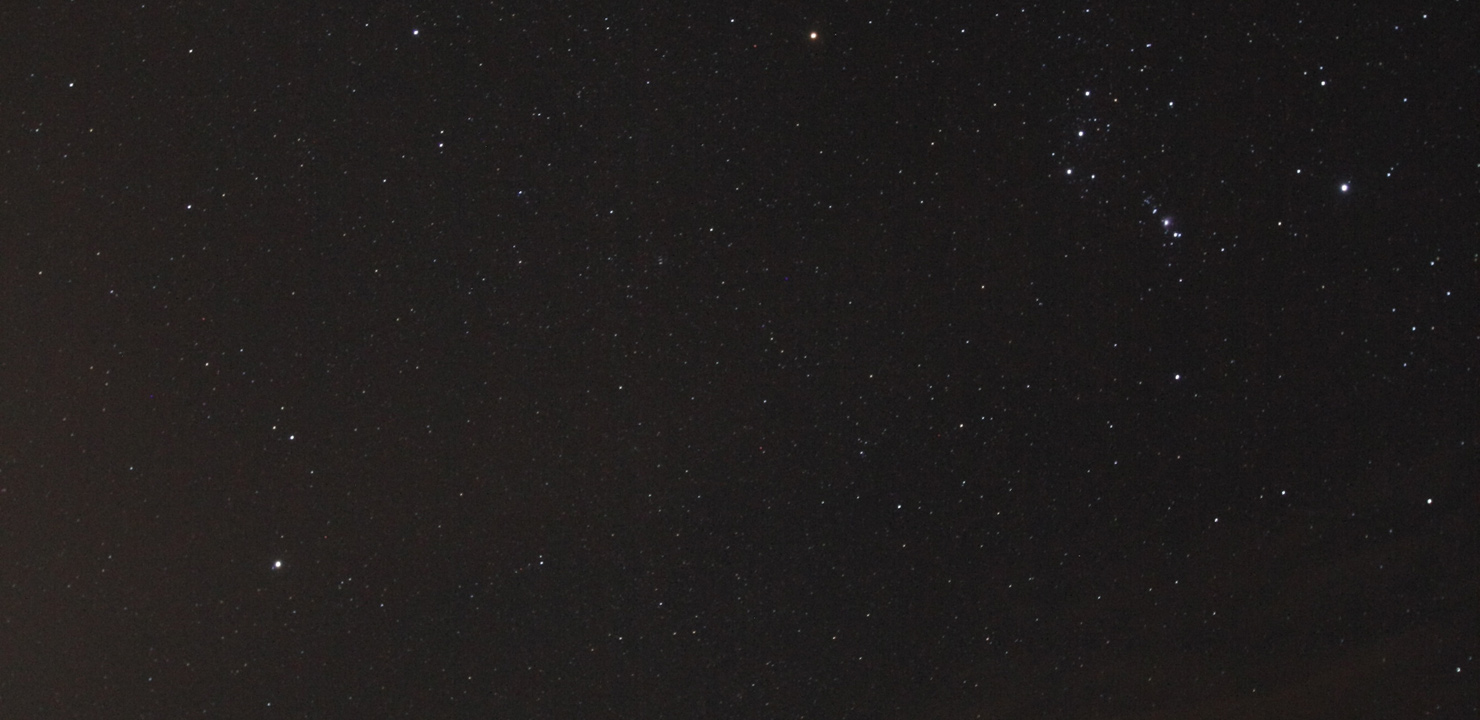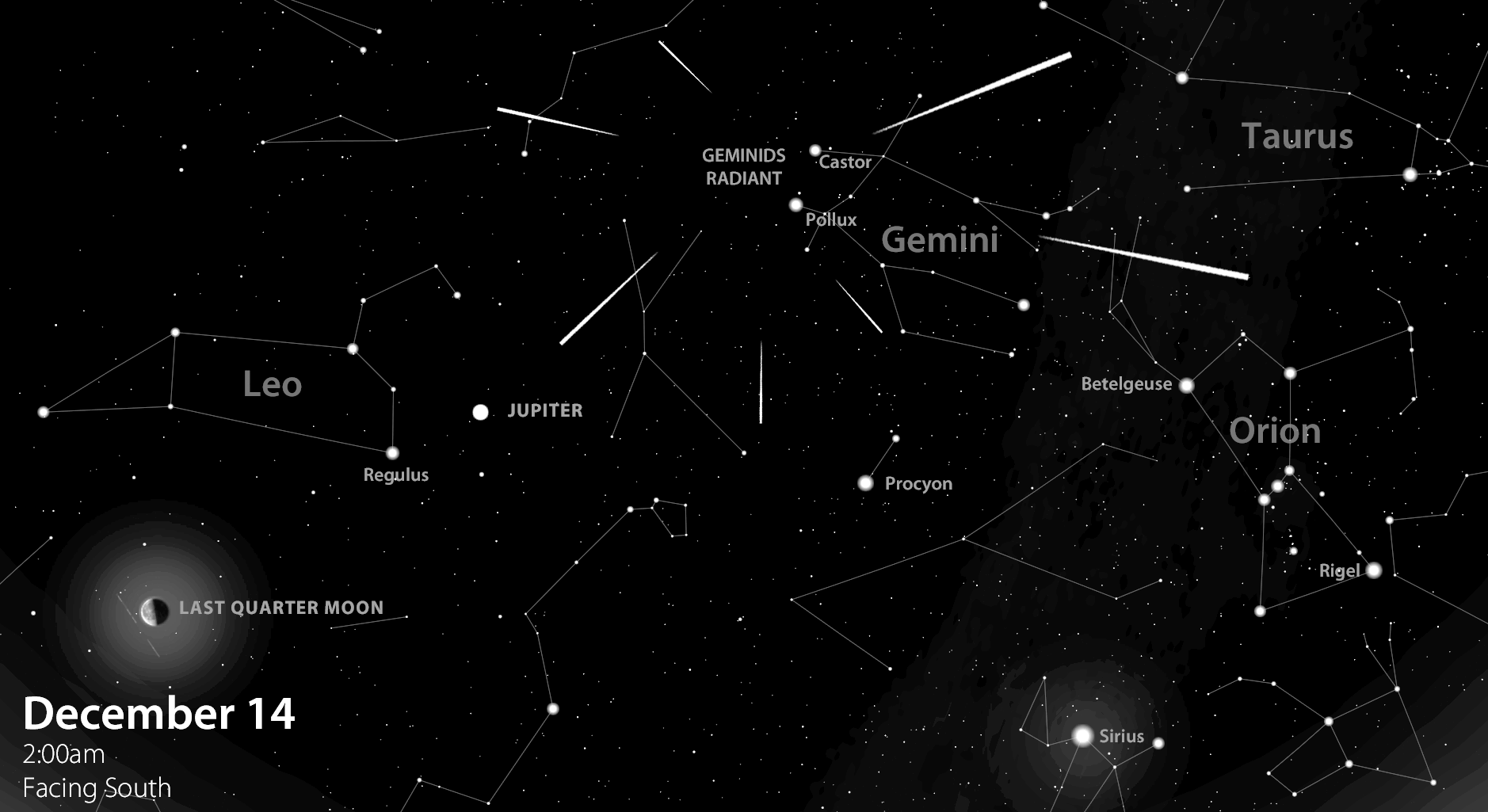
An Early Holiday Gift: the Geminid Meteor Shower
December 2014 :
Note: This article may contain outdated information
This article was published in the December 2014 issue of The Skyscraper and likely contains some information that was pertinent only for that month. It is being provided here for historical reference only.
Stargazers are a hearty group of people. During the muggy months of the year we often fight the onslaught of mosquitoes while trying to enjoy the starry sky. Then once the cold of winter sets in, you will still find many dedicated souls bravely bundling up to observe the heavens under often frigid temperatures. These circumstances can be mitigated in one way or another. But the situation that confounds us the most is clouds. Lately it seems Mother Nature is conspiring against us here in Southern New England. Inclement weather clouded out two lunar eclipses this year. Lousy weather has also spoiled several meteor showers.
And to add further insult to injury, many public nights at Ladd Observatory and Seagrave Observatory were cancelled due to poor weather conditions. It can be very frustrating when many of the events I write about cannot be observed, or when after months of planning, a star party for a local school or civic group has to be scrubbed due to cloudy skies. I have to remind myself that this is New England and the weather is often quite fickle. I can only hope that 2015 will be filled with clear skies for everyone to enjoy the wonders of the heavens.
But until the beginning of the new year there are still a few astronomical events to look forward to during December, provided Mother Nature is kind to us.
First up, on the evening of December 5-6, the waxing gibbous Moon (almost Full) will pass through the V-shaped Hyades star cluster in the constellation of Taurus. When the Moon rises around 4:00 p.m. locally, it will already be within the cluster. If you have several hours to observe, you will see the Moon slide to the east (right) through this asterism as the night progresses. At around midnight the Moon will be within one degree (two full moon diameters) from Taurus’ brightest star, orange Aldebaran, the “eye of the bull.” Anytime during this celestial show would be a good opportunity to snap a few images. It will be a very beautiful sight.
A week later, December 13-14, we will be treated to the annual gift of the Geminid meteor shower. The Moon will then be at Last Quarter and will not rise until 11:20 p.m. That’s excellent news for the Geminids, as this display can be observed during the early evening hours. This circumstance is contrary to most meteor showers. Why? The Gemini star pattern is well above the east-northeast horizon by 8:00 p.m., allowing us to view members of this display early. An observer with a good horizon may even see a few earth-grazers skim across the top of our atmosphere.
An additional advantage for many observers this year is the fact that peak night occurs on a Saturday evening to Sunday morning. To see these shooting stars to best advantage you should find a dark-sky location free from any sources of light pollution. Get comfortable and stay warm. You’ll know you’ve seen a Geminid if you can trace the origin of the meteor’s trail back to the radiant point near Gemini’s brightest stars, Castor and Pollux. The Geminids are fairly bright and moderate in speed, hitting our atmosphere at 21.75 miles per second. They are characterized by their multicolored display (65% being white, 26% yellow, and the remaining 9% blue, red and green). Geminids also have a reputation for producing exploding meteors called fireballs.

Before the Moon rises above the horizon and begins to cast its light across the heavens, an observer could potentially observe 40 meteors per hour. Peak activity occurs between midnight and dawn, with 60+ meteors per hour predicted. However, moonlight will somewhat overshadow the dimmer meteors as the Moon rises higher into the sky. Don’t just stare in the direction of Gemini. Scan around the sky as much as possible without straining your neck. I suggest lying on a lounge chair within a sleeping bag. Gemini will continue moving towards the west, staying away from the Moon. At around 2:30 a.m. Gemini will be on your meridian, just south of zenith.
Keep warm and alert, but don’t get too comfy out there. Many moons ago during a Geminid meteor shower watch from Seagrave Observatory, the sky was clear when we started observing. However, sometime during the night we all fell asleep. When we awoke we realized some clouds had paid us a visit, since we were all covered with a dusting of snow. Moral of that story is…stay awake while meteor observing during the winter. Otherwise they may have to pick you up with ice tongs and thaw you out in the morning!!
Another important astronomical event, the Winter Solstice, occurs on December 21 at 6:03 p.m. The Sun reaches its southernmost position in our sky on this date. It will then begin its migration northward and the daylight hours will lengthen as we head towards the Vernal Equinox (Spring) on March 20, 2015, at 6:45 p.m. EDT.
And finally, I briefly mentioned Jupiter last month. In December, Jupiter will still be too low in the sky to be observed from most of the local observatories during their open times. However, if you have your own telescope equipment and a good view to the east, you can start observing Jupiter right away. This huge world can be found in the constellation of Leo, seven to eight degrees to the upper right from Leo’s brightest star, blue-white Regulus. Even a small telescope will reveal Jupiter’s four Galilean moons and the primary belts and zones in his atmosphere.
When you wish to enjoy the beauty of the heavens through a telescope, please visit the local Rhode Island observatories.
Seagrave Memorial Observatory in North Scituate is open to the public every clear Saturday night, although it will be closed on December 13.
Ladd Observatory in Providence is open every clear Tuesday night.
Frosty Drew Observatory in Charlestown is open every clear Friday night year-round.
Be sure to check all the websites for the public night schedules and opening times before visiting these wonderful facilities. Wintry conditions can force unexpected closures.
Enjoy the beauty of the heavens.
Happy holidays and clear skies to all.



